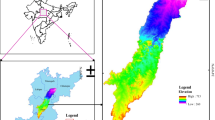Abstract
River basin management has become more dynamic and challenging due to increased competition among different water use sectors. Mae Klong Basin is rich in term of water availability, but increasing water demands in future due to inter-basin-based water management policy addressed by the national government may strongly influence the changes in water status. WEAP model was implemented to assess the current water supply and demand situations for this basin. Six different scenarios were established to evaluate the response of the basin to increasing demands under two SRES scenarios A2 and B2. The simulated results have shown that currently the water resources in the basin are sufficient to meet the existing needs in the wet season, but water shortage has occurred in the dry periods of 2014 and 2015 due to less rainfall in these years. The results have also shown that more water shortages have occurred under A2 scenario as compared to B2 scenario. Water shortages have occurred in all the developed scenarios indicating that the basin will face water scarcity particularly in the scenario five where transferring water to the adjoining area is difficult to possibly be implemented. The scenario six where a new hydropower project is proposed is considered feasible under both A2 and B2 scenarios and can help in meeting hydropower demands in the basin. It is pertinent to shape more effective policies and regulations in the basin for effective water resources management in reducing water shortage as well as achieving downstream water needs and power benefit in future.








Source: LeRoy (2005)











Similar content being viewed by others
References
Al-Omari A, Al-Quraan S, Al-Salihi A, Abdulla F (2009) A water management support system for Amman Zarqa Basin in Jordan. Water Resour Manag 23(15):3165–3189
Al-Omari AS, Al-Karablieh EK, Al-Houri ZM, Salman AZ, Al-Weshah RA (2015) Irrigation water management in the Jordan Valley under water scarcity. Fresenius Environ Bull 24:1176–1188
Ali MF, Saadon A, Rahman NA, Khalid K (2014) An assessment of water demand in malaysia using water evaluation and planning system. In: InCIEC 2013. Springer, Singapore, pp 743–755
Bejranonda W, Koch M, Koontanakulvong S (2013) Surface water and groundwater dynamic interaction models as guiding tools for optimal conjunctive water use policies in the central plain of Thailand. Environ Earth Sci 70(5):2079–2086
Biltonen E, Kwanyuen B, Kositsakulchai E, Pattani S (2003) Development of water-management institutions in the Mae Klong River Basin, Thailand. In: Bruns B, Bandaragoda DJ (eds) Governance for integrated water resources management in a river-basin context. Proceedings of a regional seminar, Bangkok, May, 2002, IWMI, Colombo, pp 109–137
Demertzi KA, Papamichail DM, Georgiou PE, Karamouzis DN, Aschonitis VG (2014) Assessment of rural and highly seasonal tourist activity plus drought effects on reservoir operation in a semi-arid region of Greece using the WEAP model. Water Int 39(1):23–34
Food and Agriculture Organization of United Nations. (1999) CROPWAT 8.0. Retrieved From http://www.fao.org/land-water/databases-and-software/cropwat/en/
Hamlat A, Errih M, Guidoum A (2013) Simulation of water resources management scenarios in western Algeria watersheds using WEAP model. Arab J Geosci 6(7):2225–2236
Hoff H, Bonzi C, Joyce B, Tielbörger K (2011) A water resources planning tool for the Jordan River Basin. Water 3(3):718–736
Ingol-Blanco E, McKinney DC (2012) Development of a hydrological model for the Rio Conchos Basin. J Hydrol Eng 18(3):340–351
Japan International Cooperation Agency, JICA (1997) Western Seaboard Regional Development Master Plan. Final report, vol 9
Kasetsart University (2016) Hydrology for Mae Klong River Basin. Retrieved from http://irre.ku.ac.th/MIIS/miis%28hydro%29/01.html. Accessed on 04 Apr 2016
Kulsuwan B (1999) Application of AQUARIUS for the Mae Klong River Basin. Engineering Project, Kasetsart University, Nakhon Pathom
LeRoy E (2005) Application of the WEAP system, Olifant catchment. MSc, thesis, Republic of South Africa
Lévite H, Sally H, Cour J (2003) Water demand management scenarios in a water-stressed basin in South Africa. In: Proceedings of the 3rd WARFSA/WaterNet Symp, pp 15–17
Moriasi DN, Arnold JG, Van Liew MW, Bingner RL, Harmel RD, Veith TL (2007) Model evaluation guidelines for systematic quantification of accuracy in watershed simulations. Trans Asabe 50(3):885–900
Royal Irrigation Department (RID) (2006) Chao Phraya Delta: Paddy Field Irrigation Area in Tidal Deposit. Retrieved from http://www.rid.go.th/thaicid/_5_article/2549/10_1ChaoPhraYaDelta.pdf. Accessed on 04 Apr 2016
Royal Irrigation Department (RID) (2011a) Crop coefficient of 40 varieties; office of hydrology and water management. Bangkok, Royal Irrigation Department
Royal Irrigation Department (RID) (2011b) Reference crop evapotranspiration by Penmen Monteith; office of hydrology and water management. Bangkok, Royal Irrigation Department
Shrestha S (2014) Assessment of water availability under climate change scenarios in Thailand. In: Climate change impacts and adaptation in water resources and water use sectors. Springer, pp 9–23
Shumet AG, Mengistu KT (2016) Assessing the impact of existing and future water demand on economic and environmental aspects (Case study from Rift Valley Lake Basin: Meki-Ziway Sub Basin), Ethiopia. Int J Waste Resour 6:223
Stockholm Environment Institute, SEI (2015) WEAP (water evaluation and planning): user’s guide. Retrieved from http://www.weap21.org/downloads/WEAP_User_Guide.pdf. Accessed on 04 Apr 2016
Swiech T, Ertsen MW, Pererya CM (2012) Estimating the impacts of a reservoir for improved water use in irrigation in the Yarabamba Region, Peru. Phys Chem Earth Parts A/B/C 47:64–75
Vongvisessomjai S (2005) Chao Phraya Delta: paddy field irrigation area in tidal deposit. In: 19th international congress and 56th international executive council of ICID (10–18 September 2005), THAICID-Multifunctional roles of irrigation water in Thailand
Vudhivanich V, Pajongkitkran S, Bunpian A, Cherdchanpipat N (2002) Irrigation efficiency of the greater Chao Phraya and the greater Mae Klong irrigation projects. Kasetsart J Nat Sci 36:110–118
Yoo C (2006) Long term analysis of wet and dry years in Seoul, Korea. J Hydrol 318(1):24–36
Author information
Authors and Affiliations
Corresponding author
Rights and permissions
About this article
Cite this article
Khalil, A., Rittima, A. & Phankamolsil, Y. The projected changes in water status of the Mae Klong Basin, Thailand, using WEAP model. Paddy Water Environ 16, 439–455 (2018). https://doi.org/10.1007/s10333-018-0638-y
Received:
Revised:
Accepted:
Published:
Issue Date:
DOI: https://doi.org/10.1007/s10333-018-0638-y




